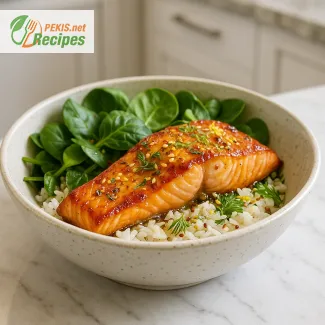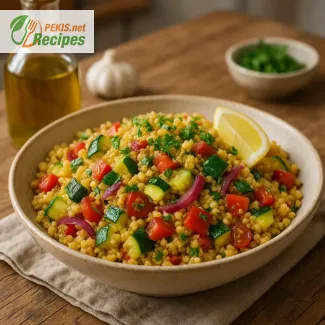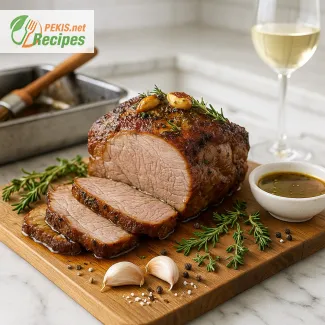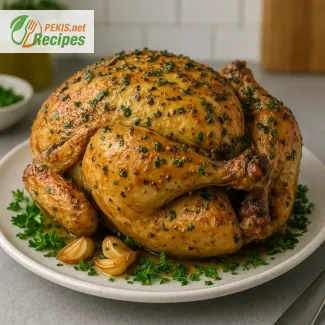Serves 4, ready in 25 minutes (10 prep, 15 cook), Rice Noodles with White Beans, Rosemary & White Truffle combines silky noodles, creamy beans, aromatic rosemary, and the luxurious depth of truffle oil. Light yet indulgent, this gluten-free dish delivers a rich, herb-infused flavor with a delicate, velvety finish.
PEKIS – professional chef and recipe developer with over 25 years of experience, specializing in European and international cuisine. This recipe has been refined through years of creating elegant pasta and noodle dishes, with a focus on pairing Mediterranean flavors and premium ingredients for exceptional dining experiences.
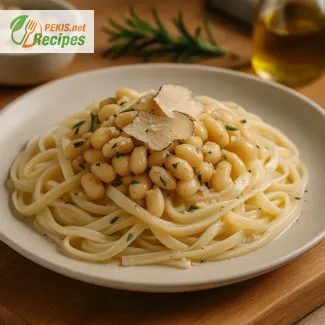
Elegant White Bean & Truffle Rice Noodles Delight
Aromatic rosemary, creamy beans, and luxurious truffle in a comforting noodle dish
Silky rice noodles soak up the aromatic infusion of fresh rosemary, the earthy depth of white beans, and the unmistakable decadence of white truffle. This combination brings together the gentle creaminess of legumes, the herbal lift of rosemary, and the indulgent umami of truffle in a way that feels both comforting and sophisticated. Served warm, the noodles provide a delicate canvas for the sauce to cling to, creating layers of flavor in every bite.
The origins of this dish lie in the meeting of rustic European flavors with Asian-inspired textures. White beans—especially varieties like cannellini—are staples of Mediterranean cuisine, where they are often paired with fragrant herbs. Rice noodles, on the other hand, have roots in East and Southeast Asian cooking, celebrated for their light, gluten-free versatility. The introduction of white truffle into this pairing transforms a humble bean-based sauce into an exquisite centerpiece worthy of fine dining, yet still achievable in a home kitchen.
Why you’ll love this recipe
- Perfect balance of creamy and aromatic flavors
- Luxurious yet made with simple pantry staples
- Naturally gluten-free for broader enjoyment
- Elegant enough for dinner parties, simple enough for weeknights
- Ready in under 30 minutes with minimal prep
Key flavor elements
- White beans: Provide creamy texture and subtle sweetness.
- Rosemary: Adds a piney, aromatic complexity.
- White truffle: Lends a rich, savory depth with unmistakable aroma.
- Rice noodles: Light yet satisfying, soaking up all the sauce flavors.
Serving ideas
- Garnish with a drizzle of truffle oil for added aroma just before serving.
- Pair with a crisp white wine or sparkling water with citrus.
- Add a handful of baby spinach or arugula for extra freshness.
Storage & Make-Ahead
- Room temperature: up to 2 days in an airtight container
- Freezing: up to 2 months, thaw overnight in the fridge
- Reheating: 150 °C / 300 °F for 8–10 minutes until heated through
Would you like me to proceed with the full recipe next using this exact introduction as the base?
- Bring a large pot of water to a boil. Add the rice noodles and cook according to package instructions until tender. Drain and set aside.
- In a large skillet, heat olive oil over medium heat. Add the minced garlic and sauté for 1–2 minutes until fragrant, avoiding browning.
- Stir in the white beans and rosemary, cooking for another 2 minutes to allow the flavors to meld.
- Pour in the vegetable broth and let it simmer for 5–6 minutes, slightly reducing the liquid.
- Add the white truffle oil and season with salt and black pepper. Adjust seasoning to taste.
- Toss the cooked rice noodles into the skillet, mixing well to coat them evenly with the sauce.
- Sprinkle with grated Parmesan cheese just before serving for extra richness.
- Serve immediately, optionally garnished with additional rosemary or a light drizzle of truffle oil.
FAQ questionCan I use canned white beans instead of cooking them from scratch?
Yes, canned white beans (such as cannellini or great northern beans) work perfectly. Just rinse and drain them before adding to remove excess sodium and improve texture.
FAQ questionWhat type of rice noodles should I use?
Medium-width flat rice noodles hold the sauce well, but thinner noodles or vermicelli can be used for a lighter texture. Adjust cooking times according to the package instructions.
FAQ questionCan I substitute the white truffle oil?
If truffle oil is unavailable, use a high-quality extra virgin olive oil and a pinch of finely grated fresh mushrooms like porcini for a deeper earthy flavor.
FAQ questionIs this dish suitable for a vegan diet?
Yes, simply replace the Parmesan cheese with nutritional yeast or a vegan hard cheese alternative.
FAQ questionHow can I make this recipe more filling?
Add sautéed mushrooms, roasted vegetables, or grilled tofu for extra protein and texture.
FAQ questionDoes this recipe contain gluten?
No, it’s naturally gluten-free if you use certified gluten-free rice noodles.
FAQ questionWhat wine pairs well with this dish?
A crisp white wine such as Pinot Grigio, Sauvignon Blanc, or a lightly oaked Chardonnay complements the herbal and truffle notes beautifully.
FAQ questionCan I make this ahead of time?
Yes. Cook the sauce and noodles separately, store them in the fridge for up to 2 days, and combine when reheating to prevent the noodles from becoming too soft.
FAQ questionHow do I store leftovers?
Keep in an airtight container in the fridge for up to 2 days, or freeze for up to 2 months. Reheat at 150 °C (300 °F) for 8–10 minutes until hot.
Elevating White Bean & Truffle Rice Noodles
Creative ways to enhance flavor, texture, and presentation
The balance of rice noodles, white beans, fresh rosemary, and white truffle creates a sophisticated base that is easy to adapt and refine. Small adjustments in ingredients and cooking methods can transform this dish from a comforting weeknight option into a show-stopping dinner. By focusing on the harmony of flavors, texture contrast, and freshness, you can take the original recipe to new heights without losing its essence.
Intensifying the flavor profile
Enhancing the aromatic backbone of this dish starts with choosing high-quality white beans. Opt for freshly cooked cannellini beans over canned varieties when possible; their creaminess and subtle sweetness provide a superior texture. Rosemary can be paired with other herbs such as thyme or sage for additional layers of aroma. For the truffle element, consider combining a small amount of freshly shaved white truffle with the truffle oil—this creates a more complex and lingering flavor.
A splash of dry white wine during the broth reduction can introduce acidity that balances the richness. If wine is not preferred, a teaspoon of lemon juice added just before serving delivers a similar brightness without altering the core flavors.
Improving texture and mouthfeel
The silky nature of rice noodles pairs well with soft beans, but introducing an element of crispness can create contrast. Lightly toasting breadcrumbs in olive oil with a pinch of salt and garlic powder makes an excellent topping. For a gluten-free crunch, roasted pumpkin seeds or crushed toasted almonds provide texture without overpowering the dish.
Cooking the noodles until just al dente prevents them from becoming too soft when mixed with the sauce. Tossing them with a small amount of olive oil before combining ensures they remain separate and evenly coated.
Boosting nutritional value
While already a nutritious recipe, incorporating leafy greens like spinach, arugula, or baby kale adds vitamins and color. Folding them into the sauce just before serving retains their vibrant hue and delicate flavor. For additional plant-based protein, stir in cubed, pan-seared tofu or cooked lentils.
Mushrooms, particularly shiitake or porcini, deepen the umami notes and complement the truffle’s earthy profile. Adding them during the sauté stage with garlic infuses the sauce with a richer base.
Common mistakes to avoid
Overcooking the rice noodles can result in a sticky, clumped texture. Always follow the package timing and rinse the noodles briefly under warm water to stop the cooking process. Another pitfall is adding the truffle oil too early—heat diminishes its delicate aroma. Instead, drizzle it in at the very end of cooking or just before serving.
Using too much salt is another frequent error, especially if using pre-salted vegetable broth. Taste the sauce before seasoning, as the Parmesan cheese and truffle oil also contribute to the overall saltiness.
Health-conscious substitutions
For a lower-fat version, reduce the olive oil by half and replace Parmesan cheese with nutritional yeast. To create a fully vegan dish, use a plant-based cheese alternative and verify that the noodles are made without egg. If sodium reduction is a goal, choose a low-sodium broth and avoid adding extra salt until tasting.
Replacing part of the white beans with chickpeas can add a nutty note and slightly firmer bite, giving the dish more variety in texture. Whole-grain rice noodles are another option for increasing dietary fiber while maintaining the familiar mouthfeel.
Enhancing presentation
A visually appealing plate elevates the dining experience. Swirl the rice noodles into a shallow bowl and spoon the bean and rosemary sauce over them, ensuring the garnishes—shaved truffle, fresh rosemary sprigs, or a light dusting of Parmesan—are visible. For a gourmet touch, finish with a drizzle of vibrant green herb oil.
Serving this dish alongside a simple mixed salad with a light vinaigrette adds freshness and balances the richness of the main flavors. Matching it with the right dinnerware, such as wide-rimmed white plates, makes the colors and textures stand out beautifully.
Why homemade is better
Preparing this dish at home allows complete control over ingredient quality and cooking technique. Fresh herbs retain their potency, beans can be cooked to the exact texture desired, and the amount of truffle oil can be perfectly calibrated to personal preference. This not only improves flavor but ensures that every element on the plate is at its peak.
Experimenting with variations based on seasonal availability keeps the recipe fresh and exciting year-round. Spring might invite the addition of tender asparagus tips, while autumn pairs well with roasted squash cubes or chestnuts. Over time, these customizations build a repertoire of refined versions that still honor the original white bean, rosemary, and truffle rice noodle concept.
Allergens present in the recipe:
- Dairy (Parmesan cheese)
Contains gluten:
- No, this recipe is naturally gluten-free when using gluten-free rice noodles.
Allergen and gluten substitution tips:
- For dairy-free: replace Parmesan cheese with nutritional yeast or a dairy-free vegan cheese.
- For a nutty flavor without dairy, use ground roasted sunflower seeds as a topping.
Vitamins and minerals per serving (approximate):
- Vitamin A: 150 µg – supports vision and immune function.
- Vitamin C: 4 mg – aids collagen production and immune health.
- Calcium: 90 mg – important for bone strength.
- Iron: 3 mg – essential for oxygen transport in the blood.
- Magnesium: 45 mg – supports muscle and nerve function.
- Potassium: 480 mg – helps regulate blood pressure and fluid balance.
Antioxidants per serving (approximate):
- Polyphenols: 40 mg – may help reduce inflammation.
- Flavonoids: 15 mg – support cardiovascular health.
- Carotenoids: 120 µg – beneficial for eye and skin health.
